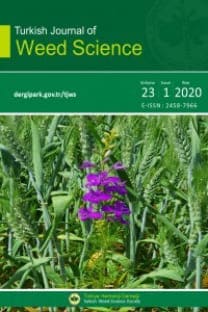Herbicidal Evaluation of the Aqueous Extract of Populus nigra L. Leaves on Six Weed Species
In a laboratory experiment, the herbicidal potential of poplar leaves was evaluated against six weed species that are Avena fatua, Phalaris minor, Rumex dentatus, Parthenium hysterophorus, Lepidium sativum and Silybum marianum. Aqueous extract of Populus nigra leaves’ powder obtained at 10, 15, and 20 g concentrations were used as treatments for testing germination and seedling growth responses of the target weed species. Germination and growth of all six weeds species were reduced with increasing concentration of the leaves. Results suggests the potential role of this plant’s extracts in the management of weeds; however, more work is needed to be conducted for identification of the allelochemicals present in poplar plant which exhibit inhibitory activities against seed germination and growth parameters of test plants.
Anahtar Kelimeler:
Populus nigra; weed suppression, herbicidal potential, growth regulators, , phenolics
Herbicidal Evaluation of the Aqueous Extract of Populus nigra L. Leaves on Six Weed Species
In a laboratory experiment, the allelopathic potentials of poplar leaves were evaluated against six different weeds. Populus nigra leaves (PNLs) powder 10 15g and 20g concentrations were soaked discretely in 200ml distilled water for 96 hours with infrequent shaking and were filtered to get aqueous extracts, tested against six weedy species viz. Avena fatua, Phalaris minor), Rumex dentatus, Parthenium hysterophorus, Lepidium sativum and Silybum marianum with a view to explore its herbicidal potential. Germination and growth of all six weeds species was reduced with increasing concentration of the leaves and a dose-response relationship was observed. Results suggests the potential role of these plant extracts in the management of weeds; however, more work is needed to be conducted for identification of the allelochemicals present in poplar plant which exhibit inhibitory activities against seed germination and growth parameters of test plants.
___
- Ahmed, R., Hoque, A. R., & Hossain, M. K. (2008). Allelopathic effects of Leucaena leucocephala leaf litter on some forest and agricultural crops grown in nursery. Journal of Forestry Research, 19(4), 298.Akhtar, S., N. Bangash, R. Asghar, M. Munir and N. Khalid. 2014. Allelopathic assessment of selected invasive species of Pakistan. Pak. J. Bot., 46(5): 1709-1713.Araniti, F., A. Sorgonà, A. Lupini and M. R. Abenavoli. 2012. Screening of Mediterranean wild plant species for allelopathic activity and their use as bio-herbicides. Allelo. J., 29 (1): 107-124.Bansal, G.L. and V. M. Bhan. 1993. Status of research on Allelopathy and future scope of workin India. Indian Journal of. Agricultural Science, 63: 769-776.Barkatullah, F. Hussain and M. Ibrar. 2010. Allelopathic potential of Dodonaea viscosa (l.) Jacq. Pak. J. Bot., 42(4): 2383-2390.Chon SU, Jang HG, Kim DK, Kim YM, Boo HO, Kim YJ. 2005. Allelopathic potential in lettuce (Lectuca sativa L.) plant. Scientia Horticulturea, 206(3): 309-317.Dorning, M. and D. Cipollini. 2006. Leaf and root extracts of the invasive shrub, Lonicera maackii, inhibit seed germination of three herbs with no autotoxic effects. Plant Ecology 184: 287-296.Hadi F, Naila S, Ibrar M, Barkatullah & Rashid A (2014). Allelopathic impact of Phragmites karka on seed germination and radical and hypocotyle growth of wheat variety sirin-2007. Sch J Agric Sci 4(7): 427-431Hussain, F., F. Niaz, M. Jabeen and T. Burni. 2004. Allelopathic potential of Broussonetia papyrifera Vent. Pak. J. Pl. Sci., 10(2) 69-77.Levin, D.A. 1976. The chemical defenses of plants to pathogens and herbivores. Annual Review of Ecological System, 7: 121-159.Majeed, A., Chaudhry, Z., & Muhammad, Z. (2012). Allelopathic assessment of fresh aqueous extracts of Chenopodium album L. for growth and yield of wheat (Triticum aestivum L.). Pak. J. Bot, 44(1), 165-167.Majeed, A., Muhammad, Z., & Ahmad, H. (2018). Plant growth promoting bacteria: role in soil improvement, abiotic and biotic stress management of crops. Plant cell reports, 1-11.Narwal SS (1994). Allelopathy and Soil Analysis. Sci. Publishers Jodhpur Ind. 288.Ortega, R.C., A.L. Anaya and L. Ramos. 1988. Effects of allelopathic compounds of corn pollen on respiration and cell division of watermelon. J. Chem. Ecol., 14:71-86.Parvin, R., Shapla, T. L., & Amin, M. H. A. (2011). Allelopathic effects of Albizia lebbeck on agricultural crops. Int. J. Sustain. Crop Prod, 6(1), 50-57.Pelinganga O. and P.W. Mashela 2012. Mean dosage stimulation range of allelochemicals from crude extracts of Cucumis africanus fruit for improving growth of tomato plant and suppressing Meloidogyne incognita numbers. J. Agric. Sci., 4(12): 34-45.Tawaha AM & Turk MA. 2003. Allelopathic effects of black mustard. Brassica nigra on germination and growth of wild barley. Hordeum spontaneum. Journal of Agronomy and Crop Science, 189: 298-303.Wabo, P.J., N.J.D. Ngankam, B.C.F. Bilong and M. Mpoame. 2011. A comparative study of the ovicidal and larvicidal activities of aqueous and ethanolic extracts of pawpaw seeds Carica papaya (caricaceae) on Heligmosomoides bakeri. Asian Pac. J. Trop. Med., 24: 447-450.Wakjira, M., Berecha, G., & Bulti, B. (2005). Allelopathic effects of Parthenium hysterophorus extracts on seed germination and seedling growth of lettuce. Tropical Science, 45(4), 159-162.Xuan, T. D., E. Tsuzuki, T. Hiruki, M. Mitsuhiro, T. D. Khanh and I. M. Chung. 2004. Evaluation of phytotoxicity of neem (Azadirachta indica A. Juss) to crops and weeds. Crop Protection, 23(4): 335- 345.Yamada, K., Hondo, M., Shigemori, H., Hirose, K., & Hasegawa, K. (2010). Physiological effects of lepidimoic acid (a stimulatory allelochemical) on cucumber cotyledons. Allelopathy Journal, 25(2).
- ISSN: 1303-6491
- Başlangıç: 1998
- Yayıncı: Türkiye Herboloji Derneği
Sayıdaki Diğer Makaleler
Olcay BOZDOĞAN, Yücel KARAMAN, Nihat TURSUN
Sabriye BELGÜZAR, Yusuf YANAR, Merve ÇETİN, Çiğdem ÖZYİĞİT
Mine ÖZKİL, Ahmet Tansel SERİM, Hilmi TORUN, İlhan ÜREMİŞ
Identity of the Casuarina sp. in Turkey
İan Timothy RILEY, Leyla Nur KORKMAZ
İnsansız Hava Aracı (İHA) ve Görüntü İşleme Teknikleri Kullanılarak Yabancı Ot Tespitinin Yapılması
Herbicidal Evaluation of the Aqueous Extract of Populus nigra L. Leaves on Six Weed Species
Zahir MUHAMMAD, Naila INAYAT, Rasool KHAN, Muhammad QURADA, Rehman ULLAH, Abdul MAJEED
